
Concept explainers
Draw a three-dimensional representation for each molecule. Indicate which ones have a dipole moment and in what direction it is pointing.
- (a) CH3F
- (b) CH2Cl2
- (c) CH2ClBr
- (d) CFCl3
- (e) CCl4
- (f) CH2=CCl2
- (g) CH2=CHCl
- (h) HC≡C—C≡CH
- (i) CH3C≡N
- (j) (CH3)2C=O
- (k) BrCH=CHBr (two answers)
(a)
Interpretation:
The Three-dimensional representation for the molecule has to be drawn and dipole movement, the direction of its dipole moment has to be identified.
Concept introduction:
Polar Molecules:
Polar Molecules contains partial positive and partial negative charge in the molecule due its electronegativity difference between the molecules.
Dipole moment:
The charge separation of the molecule produces dipole moment. Dipole moment arises between two ions in an ionic bond or covalent bond.
Dipole moment depends on the differences in electronegativity of the atom in the molecule. The electronegativity is more, the larger the dipole moment. The dipole moment is calculated from the polarity of the molecule.
Explanation of Solution
The given compound is shown below,
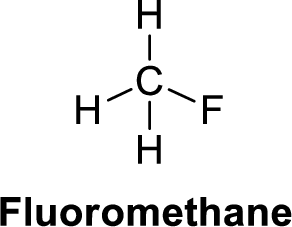
Fluoromethane is polar molecule because it has more electronegativity fluorine atom. The structure of fluoromethane is given below,

Fluorine is more electronegative than carbon and hydrogen. Carbon is more electronegative than hydrogen.
The direction of dipole moment in dichloromethane is given below,

The Three-dimensional representation for the molecule is shown below,
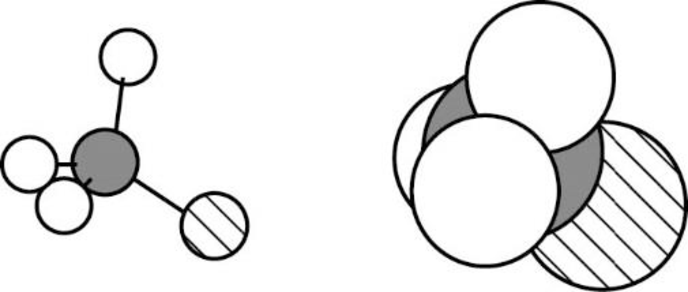
Figure 1
(b)
Interpretation:
Three-dimensional representation for the molecule has to be drawn and dipole movement, the direction of its dipole moment has to be identified.
Concept introduction:
Polar Molecules:
Polar Molecules contains partial positive and partial negative charge in the molecule due its electronegativity difference between the molecules.
Dipole moment:
The charge separation of the molecule produces dipole moment. Dipole moment arises between two ions in an ionic bond or covalent bond.
Dipole moment depends on the differences in electronegativity of the atom in the molecule. The electronegativity is more, the larger the dipole moment. The dipole moment is calculated from the polarity of the molecule.
Explanation of Solution
The given compound is shown below,
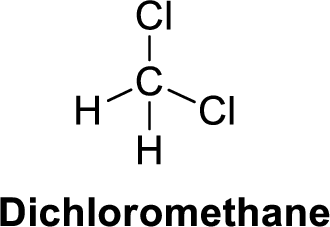
Dichloromethane is polar molecule because it has more electronegativity chlorine atom. The structure of dichloromethane is given below,

Chlorine is more electronegative than carbon and hydrogen. Carbon is more electronegative than hydrogen.
The direction of dipole moment in dichloromethane is given below,
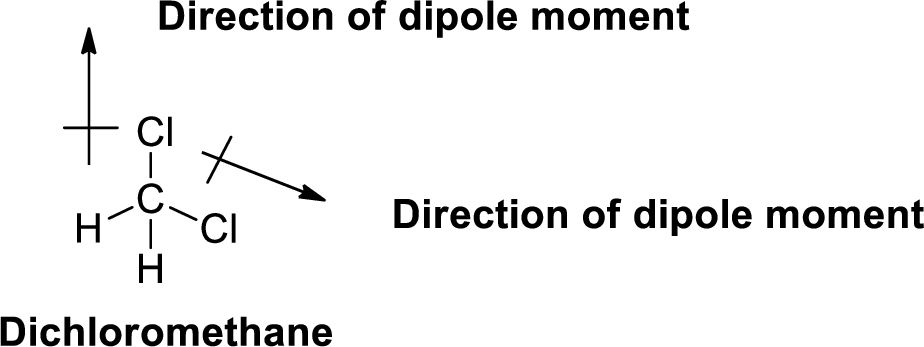
The Three-dimensional representation for the molecule is shown below,
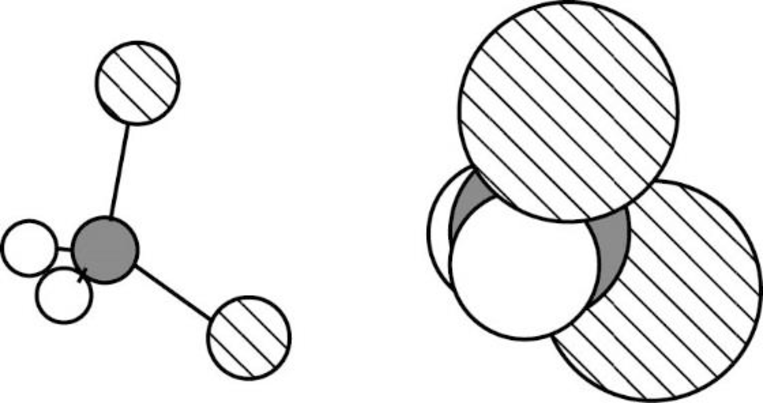
Figure 2
(c)
Interpretation:
Three-dimensional representation for the molecule has to be drawn and dipole movement, the direction of its dipole moment has to be identified.
Concept introduction:
Polar Molecules:
Polar Molecules contains partial positive and partial negative charge in the molecule due its electronegativity difference between the molecules.
Dipole moment:
The charge separation of the molecule produces dipole moment. Dipole moment arises between two ions in an ionic bond or covalent bond.
Dipole moment depends on the differences in electronegativity of the atom in the molecule. The electronegativity is more, the larger the dipole moment. The dipole moment is calculated from the polarity of the molecule.
Explanation of Solution
The given compound is shown below,
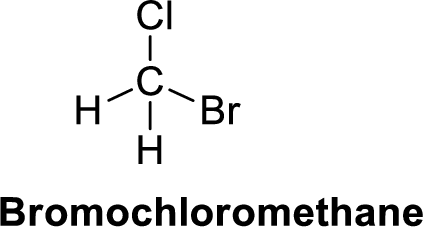
Bromochloromethane is polar molecule because it has more electronegativity chlorine and bromine atom. The structure of Bromochloromethane is given below,

Chlorine is more electronegative than carbon and hydrogen, similarly bromine is more electronegative than carbon and hydrogen. Carbon is more electronegative than hydrogen.
The direction of dipole moment in Bromochloromethane is given below,

The Three-dimensional representation for the molecule is shown below,
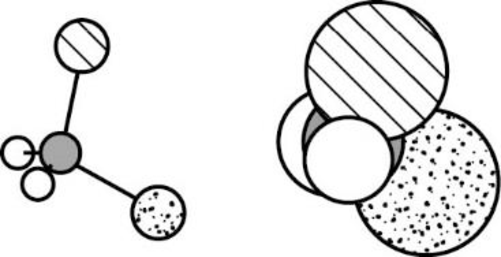
Figure 3
(d)
Interpretation:
Three-dimensional representation for the molecule has to be drawn and dipole movement, the direction of its dipole moment has to be identified.
Concept introduction:
Polar Molecules:
Polar Molecules contains partial positive and partial negative charge in the molecule due its electronegativity difference between the molecules.
Dipole moment:
The charge separation of the molecule produces dipole moment. Dipole moment arises between two ions in an ionic bond or covalent bond.
Dipole moment depends on the differences in electronegativity of the atom in the molecule. The electronegativity is more, the larger the dipole moment. The dipole moment is calculated from the polarity of the molecule.
Explanation of Solution
The given compound is shown below,
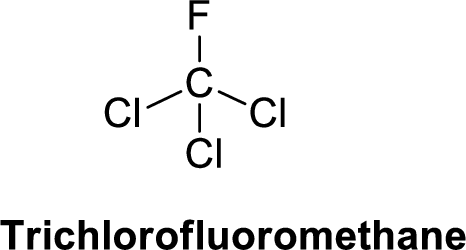
Trichlorofluoromethane is polar molecule because it has more electronegativity fluorine atom and chlorine atom. The structure of Trichlorofluoromethane is given below,
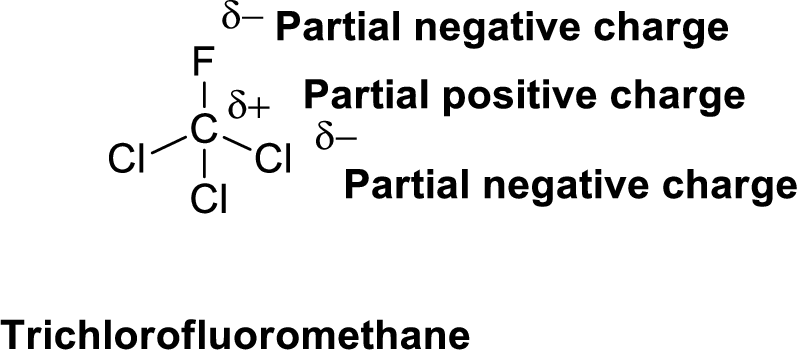
Fluorine is more electronegative than chlorine and carbon, similarly chlorine is more electronegative than carbon.
The direction of dipole moment in Trichlorofluoromethane is given below,

The Three-dimensional representation for the molecule is shown below,
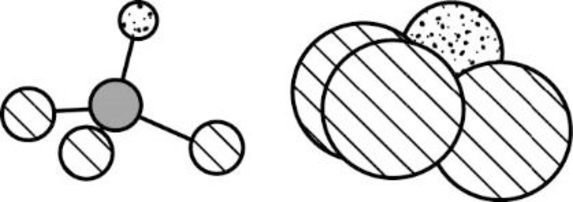
Figure 4
(e)
Interpretation:
Three-dimensional representation for the molecule has to be drawn and dipole movement, the direction of its dipole moment has to be identified.
Concept introduction:
Polar Molecules:
Polar Molecules contains partial positive and partial negative charge in the molecule due its electronegativity difference between the molecules.
Dipole moment:
The charge separation of the molecule produces dipole moment. Dipole moment arises between two ions in an ionic bond or covalent bond.
Dipole moment depends on the differences in electronegativity of the atom in the molecule. The electronegativity is more, the larger the dipole moment. The dipole moment is calculated from the polarity of the molecule.
Explanation of Solution
The given compound is shown below,
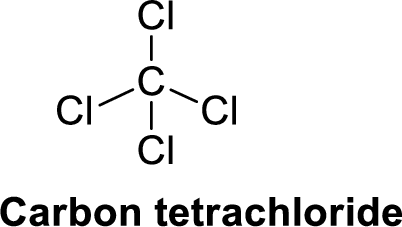
Carbon tetrachloride is polar molecule because it has more electronegativity chlorine. The structure of Carbon tetrachloride is given below,
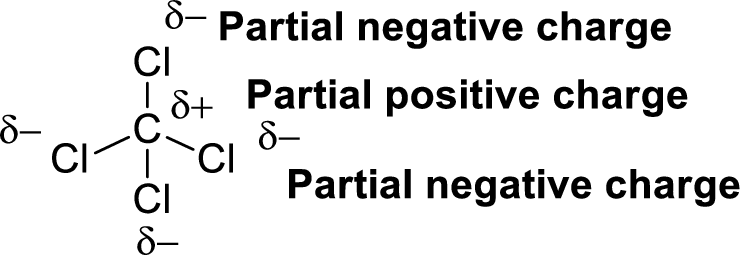
Chlorine is more electronegative than carbon. The direction of dipole moment in Carbon tetrachloride is given below,

The Three-dimensional representation for the molecule is shown below,
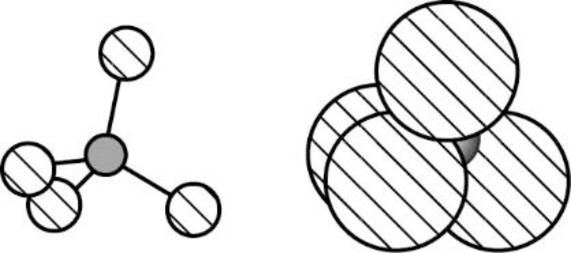
Figure 5
(f)
Interpretation:
Three-dimensional representation for the molecule has to be drawn and dipole movement, the direction of its dipole moment has to be identified.
Concept introduction:
Polar Molecules:
Polar Molecules contains partial positive and partial negative charge in the molecule due its electronegativity difference between the molecules.
Dipole moment:
The charge separation of the molecule produces dipole moment. Dipole moment arises between two ions in an ionic bond or covalent bond.
Dipole moment depends on the differences in electronegativity of the atom in the molecule. The electronegativity is more, the larger the dipole moment. The dipole moment is calculated from the polarity of the molecule.
Explanation of Solution
The given compound is shown below,
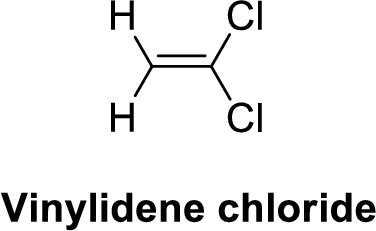
Vinylidene chloride is polar molecule because it has more electronegativity chlorine. The structure of Vinylidene chloride is given below,

Chlorine is more electronegative than carbon and hydrogen, similarly Carbon is more electronegative than hydrogen.
The direction of dipole moment in Vinylidene chloride is given below,

The Three-dimensional representation for the molecule is shown below,
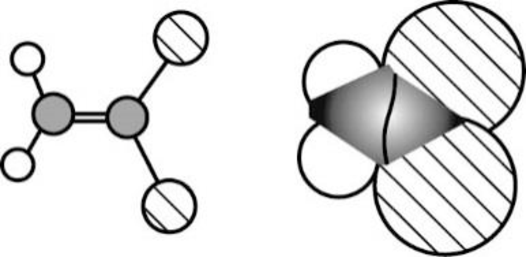
Figure 6
(g)
Interpretation:
Three-dimensional representation for the molecule has to be drawn and dipole movement, the direction of its dipole moment has to be identified.
Concept introduction:
Polar Molecules:
Polar Molecules contains partial positive and partial negative charge in the molecule due its electronegativity difference between the molecules.
Dipole moment:
The charge separation of the molecule produces dipole moment. Dipole moment arises between two ions in an ionic bond or covalent bond.
Dipole moment depends on the differences in electronegativity of the atom in the molecule. The electronegativity is more, the larger the dipole moment. The dipole moment is calculated from the polarity of the molecule.
Explanation of Solution
The given compound is shown below,
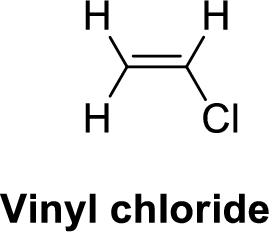
Vinyl chloride is polar molecule because it has more electronegativity chlorine. The structure of Vinyl chloride is given below,

Chlorine is more electronegative than carbon and hydrogen, similarly Carbon is more electronegative than hydrogen.
The direction of dipole moment in Vinyl chloride is given below,

The Three-dimensional representation for the molecule is shown below,
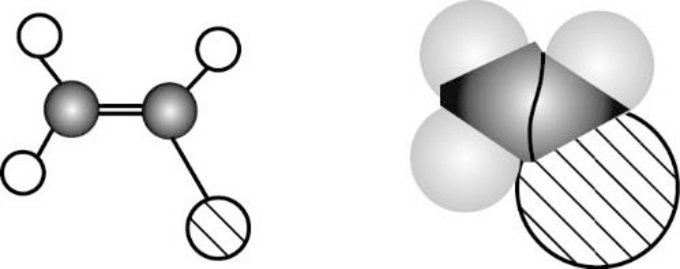
Figure 7
(h)
Interpretation:
Three-dimensional representation for the molecule has to be drawn and dipole movement, the direction of its dipole moment has to be identified.
Concept introduction:
Polar Molecules:
Polar Molecules contains partial positive and partial negative charge in the molecule due its electronegativity difference between the molecules.
Dipole moment:
The charge separation of the molecule produces dipole moment. Dipole moment arises between two ions in an ionic bond or covalent bond.
Dipole moment depends on the differences in electronegativity of the atom in the molecule. The electronegativity is more, the larger the dipole moment. The dipole moment is calculated from the polarity of the molecule.
Explanation of Solution
The given compound is non-polar molecule. The structure of compound is given below,

Carbon is more electronegative than hydrogen.
The direction of dipole moment in of the given compound is given below,

The Three-dimensional representation for the molecule is shown below,

Figure 8
(i)
Interpretation:
Three-dimensional representation for the molecule has to be drawn and dipole movement, the direction of its dipole moment has to be identified.
Concept introduction:
Polar Molecules:
Polar Molecules contains partial positive and partial negative charge in the molecule due its electronegativity difference between the molecules.
Dipole moment:
The charge separation of the molecule produces dipole moment. Dipole moment arises between two ions in an ionic bond or covalent bond.
Dipole moment depends on the differences in electronegativity of the atom in the molecule. The electronegativity is more, the larger the dipole moment. The dipole moment is calculated from the polarity of the molecule.
Explanation of Solution
The given compound is shown below,
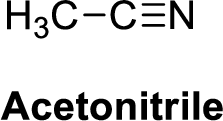
Acetonitrile is polar molecule because it has more electronegativity nitrogen atom. The structure of Acetonitrile is given below,

Nitrogen is more electronegative than carbon and hydrogen, similarly Carbon is more electronegative than hydrogen.
The direction of dipole moment in acetonitrile is given below,

The Three-dimensional representation for the molecule is shown below,

Figure 9
(j)
Interpretation:
Three-dimensional representation for the molecule has to be drawn and dipole movement, the direction of its dipole moment has to be identified.
Concept introduction:
Polar Molecules:
Polar Molecules contains partial positive and partial negative charge in the molecule due its electronegativity difference between the molecules.
Dipole moment:
The charge separation of the molecule produces dipole moment. Dipole moment arises between two ions in an ionic bond or covalent bond.
Dipole moment depends on the differences in electronegativity of the atom in the molecule. The electronegativity is more, the larger the dipole moment. The dipole moment is calculated from the polarity of the molecule.
Explanation of Solution
The given compound is shown below,
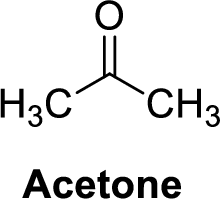
Acetone is polar molecule because it has more electronegativity oxygen atom. The structure of acetone is given below,
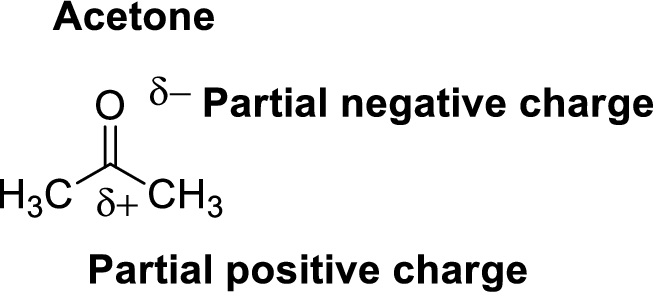
Oxygen is more electronegative than carbon and hydrogen, similarly Carbon is more electronegative than hydrogen.
The direction of dipole moment in acetone is given below,
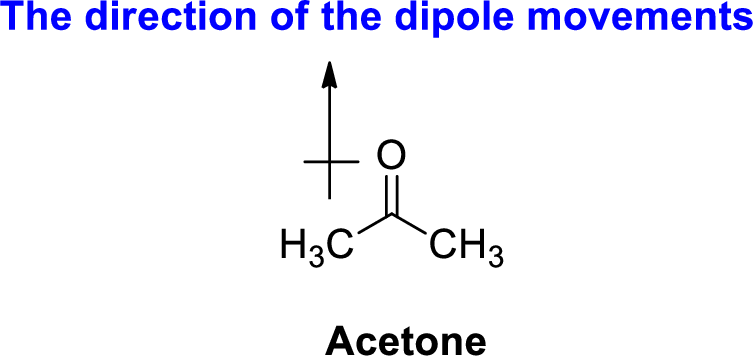
The Three-dimensional representation for the molecule is shown below,
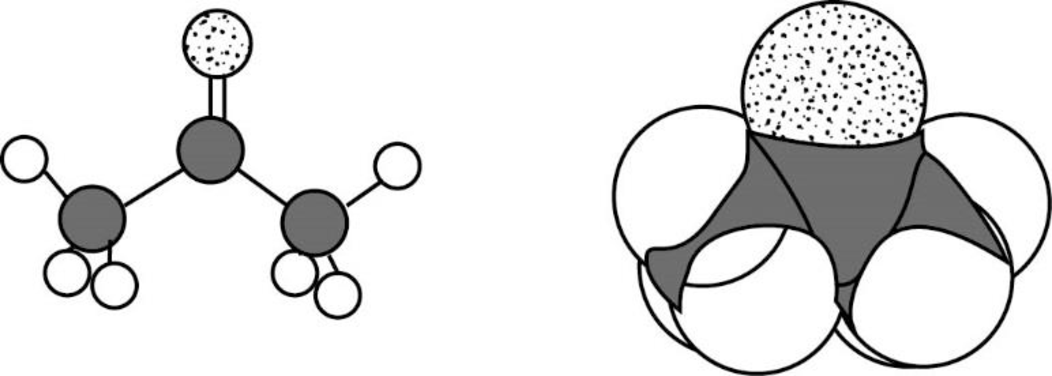
Figure 10
(k)
Interpretation:
Three-dimensional representation for the molecule has to be drawn and dipole movement, the direction of its dipole moment has to be identified.
Concept introduction:
Polar Molecules:
Polar Molecules contains partial positive and partial negative charge in the molecule due its electronegativity difference between the molecules.
Dipole moment:
The charge separation of the molecule produces dipole moment. Dipole moment arises between two ions in an ionic bond or covalent bond.
Dipole moment depends on the differences in electronegativity of the atom in the molecule. The electronegativity is more, the larger the dipole moment. The dipole moment is calculated from the polarity of the molecule.
Explanation of Solution
The given compound 1,2-Dibromoethylene, therefore it has two form
- (i) Cis 1,2-Dibromoethylene
- (ii) Trans- 1,2-Dibromoethylene
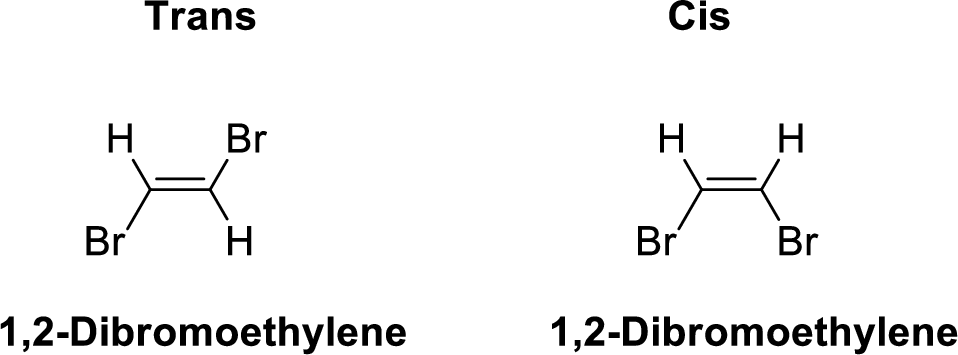
1,2-Dibromoethylene is polar molecule because it has more electronegativity bromine atom. The structure of 1,2-Dibromoethylene is given below,

Bromine is more electronegative than carbon and hydrogen, similarly Carbon is more electronegative than hydrogen.
The direction of dipole moment in 1,2-Dibromoethylene is given below,
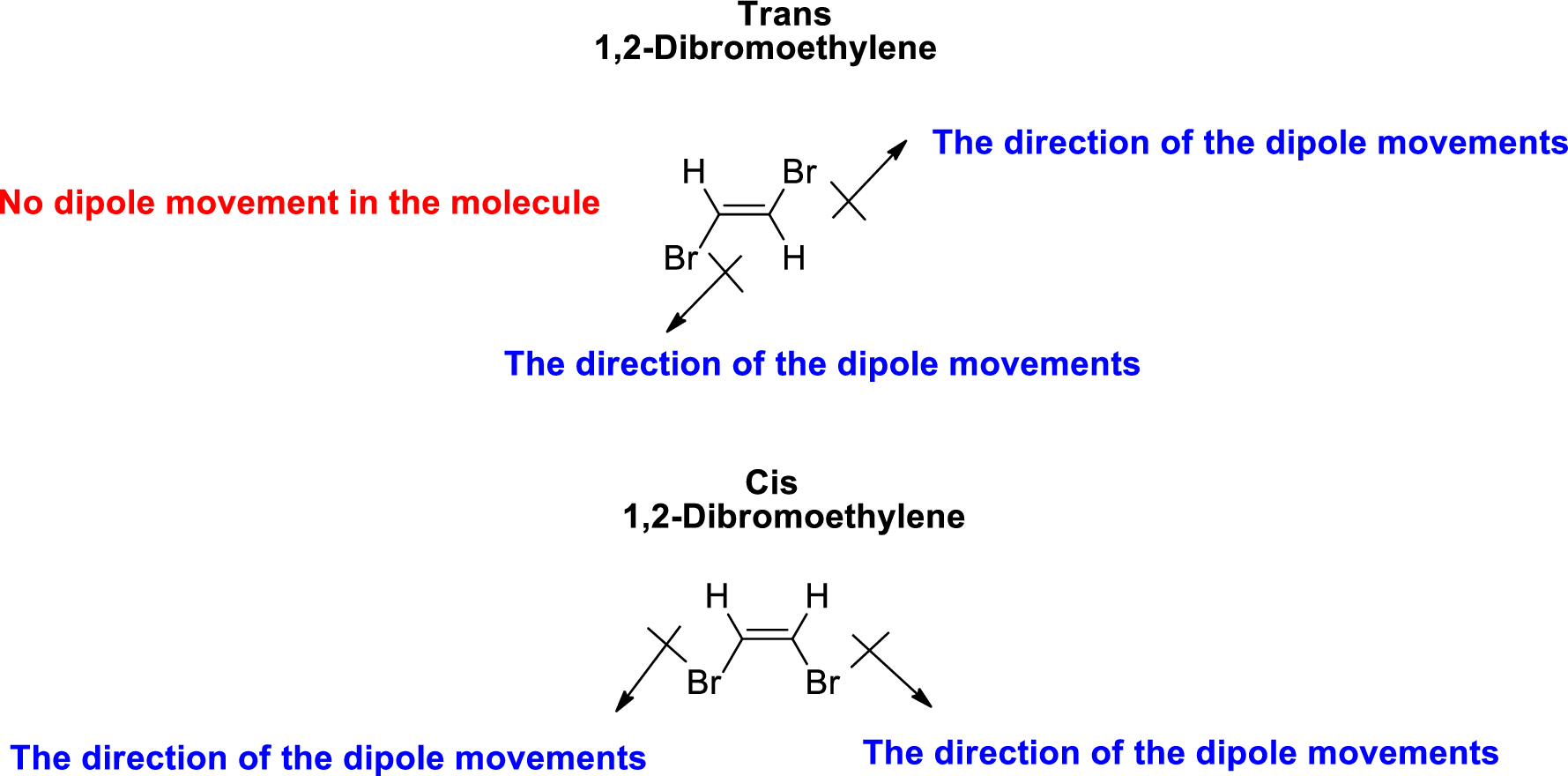
The Three-dimensional representation for the molecule is shown below,
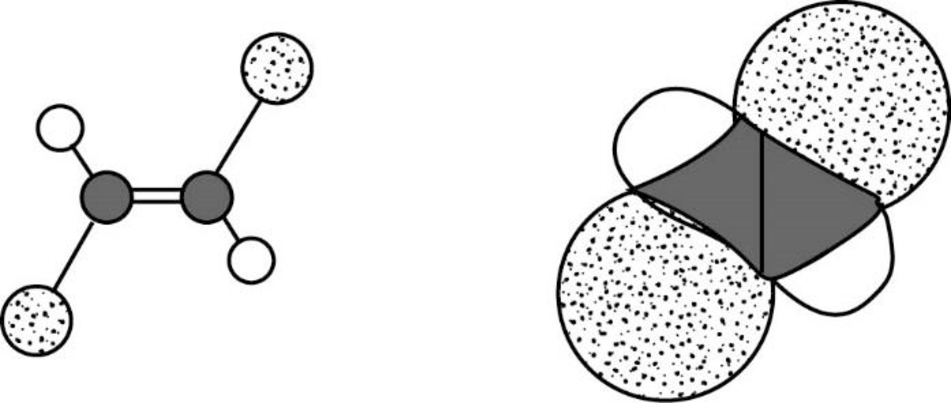
Figure 11
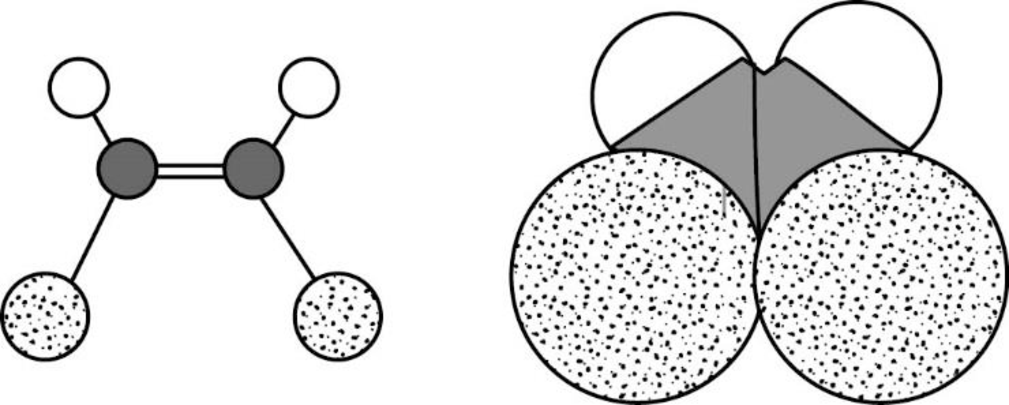
Figure 12
Want to see more full solutions like this?
Chapter 1 Solutions
Organic Chemistry, Loose-leaf Version
- The emission data in cps displayed in Table 1 is reported to two decimal places by the chemist. However, the instrument output is shown in Table 2. Table 2. Iron emission from ICP-AES Sample Blank Standard Emission, cps 579.503252562 9308340.13122 Unknown Sample 343.232365741 Did the chemist make the correct choice in how they choose to display the data up in Table 1? Choose the best explanation from the choices below. No. Since the instrument calculates 12 digits for all values, they should all be kept and not truncated. Doing so would eliminate significant information. No. Since the instrument calculates 5 decimal places for the standard, all of the values should be limited to the same number. The other decimal places are not significant for the blank and unknown sample. Yes. The way Saman made the standards was limited by the 250-mL volumetric flask. This glassware can report values to 2 decimal places, and this establishes our number of significant figures. Yes. Instrumental data…arrow_forwardSteps and explanation pleasearrow_forwardSteps and explanation to undertand concepts.arrow_forward
- Nonearrow_forward7. Draw a curved arrow mechanism for the following reaction. HO cat. HCI OH in dioxane with 4A molecular sievesarrow_forwardTry: Convert the given 3D perspective structure to Newman projection about C2 - C3 bond (C2 carbon in the front). Also, show Newman projection of other possible staggered conformers and circle the most stable conformation. Use the template shown. F H3C Br Harrow_forward
- Nonearrow_forward16. Consider the probability distribution p(x) = ax", 0 ≤ x ≤ 1 for a positive integer n. A. Derive an expression for the constant a, to normalize p(x). B. Compute the average (x) as a function of n. C. Compute σ2 = (x²) - (x)², the variance of x, as a function of n.arrow_forward451. Use the diffusion model from lecture that showed the likelihood of mixing occurring in a lattice model with eight lattice sites: Case Left Right A B C Permeable Barrier → and show that with 2V lattice sites on each side of the permeable barrier and a total of 2V white particles and 2V black particles, that perfect de-mixing (all one color on each side of the barrier) becomes increasingly unlikely as V increases.arrow_forward
 Chemistry: The Molecular ScienceChemistryISBN:9781285199047Author:John W. Moore, Conrad L. StanitskiPublisher:Cengage Learning
Chemistry: The Molecular ScienceChemistryISBN:9781285199047Author:John W. Moore, Conrad L. StanitskiPublisher:Cengage Learning Introduction to General, Organic and BiochemistryChemistryISBN:9781285869759Author:Frederick A. Bettelheim, William H. Brown, Mary K. Campbell, Shawn O. Farrell, Omar TorresPublisher:Cengage Learning
Introduction to General, Organic and BiochemistryChemistryISBN:9781285869759Author:Frederick A. Bettelheim, William H. Brown, Mary K. Campbell, Shawn O. Farrell, Omar TorresPublisher:Cengage Learning

